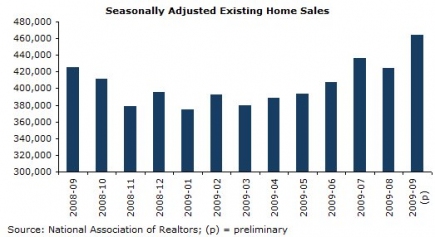November 17, 2009
November 18, 2009 (Housing Market Monitor)
By Dean Baker
November 18, 2009
The 60-day delinquency rate in the 3rd quarter was 58 percent above the year-ago level.
There appeared to be a sharp falloff in the housing market in October, as the November 30th expiration date for the first-time homebuyers tax credit approached. As expected, this credit pulled home purchases forward, leading to a substantial increase in sales in the late summer and early fall. The National Association of Realtors’ Pending Home Sales Index increased 6.1 percent from August to September and stood 21.2 percent above its year-ago level.

Given the lead time between contracting and closing, September was the last full month in which homebuyers could have signed a contract and been confident of closing in time to meet the deadline for the tax credit passed in February. While this led to a rush of buyers wanting to get in before the deadline, it also meant that there would be a sharp falloff in sales in subsequent months. This appears to have been born out by the data from the Mortgage Bankers Association’s Mortgage Applications Index. The index shows a sharp drop in purchase applications through October, with the index hitting its lowest level since 1997.
The extension and expansion of the homebuyer tax credit by Congress should give a modest boost to sales, but it is unlikely to have nearly as large an impact as the original credit. Most potential first-time buyers will have already purchased their homes. The extension of the credit to existing homeowners will provide some additional incentive for homeowners to buy a new home now (it also provides serious opportunities for gaming), but this will have little net effect on the market. Most current homeowners who opt to take advantage of the tax credit will put their home on the market, leaving no net change in the balance between supply and demand.
Even with the falloff following the expiration of the tax credit, the market is likely to remain reasonably stable for the next few months as most sellers wait out the slow winter months. By spring, mortgage rates will likely have begun to rise, assuming that the Fed does not extend its purchases of mortgage-backed securities past the first quarter. The end of these purchases will almost certainly raise interest rates by at least 50 basis points, possibly as much as 100. While this would still leave 30-year mortgage rates at a relatively low 6.0 percent, this would substantially dampen the housing market. The scheduled expiration of the new credit at the end of April should also slow demand next spring.
A third factor that could have an important impact on the market is the lending practices of the Federal Housing Administration. With the agency now below its minimum capital requirements, there is pressure to tighten lending standards. It is now buying up nearly a quarter of new mortgages. If it were to cut back these purchases by 20 percent, this would mean that 5 percent of potential homebuyers would have to turn elsewhere for mortgages. Since most homebuyers go to the FHA because they could not get private financing, a substantial cutback in FHA loans is likely to have a noticeable impact on the market.
The underlying glut in housing means that it is only a matter of time before house prices begin to fall again. Delinquencies hit another record in the third quarter of 2009. The 6.25 percent 60-day delinquency rate was 58 percent above the level for the third quarter of 2008. Even with a higher percentage of delinquent homeowners now benefiting from mortgage modifications, the foreclosure rate is still running at near record levels. With unemployment virtually certain to remain high well into next year, there is little prospect for any sizable drop in foreclosures.
As a result, foreclosures will be putting homes on the market at an annual rate of close to a 2 million. This is guaranteed to depress prices in a market with total demand of close to 5 million. In short, house prices will almost certainly resume their decline. The only questions are how soon and how fast.
Dean Baker is Co-Director of the Center for Economic and Policy Research, in Washington, D.C. CEPR’s Housing Market Monitor is published weekly and provides an incisive breakdown of the latest indicators and developments in the housing sector.






